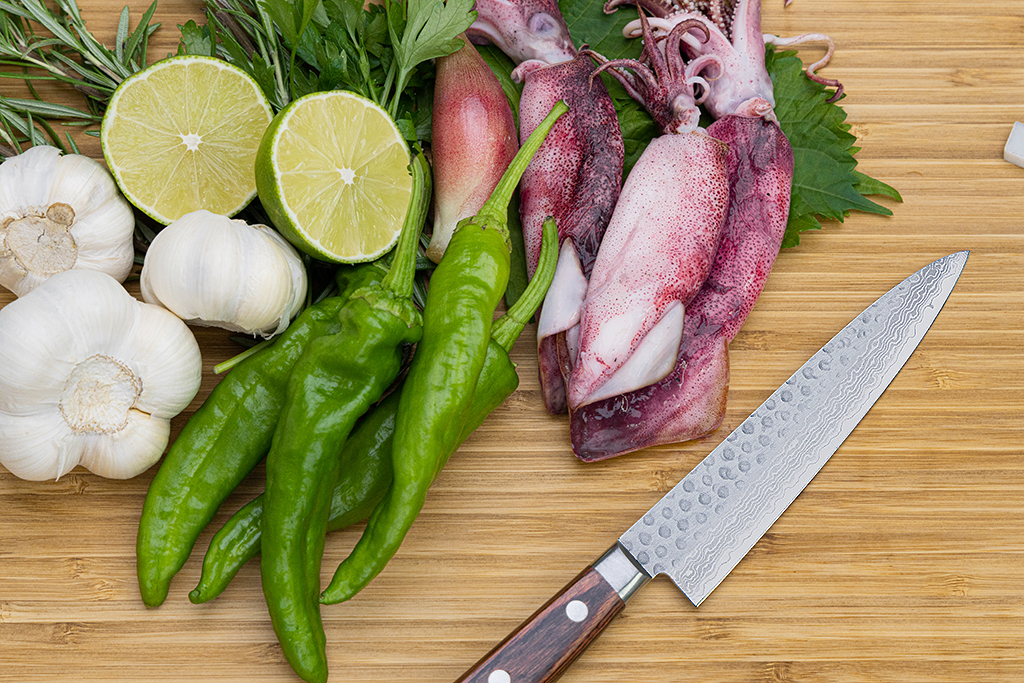The Gyuto chef knife is the Japanese version of the common Western chef’s knife.
Japanese chefs employ a range of techniques to rustle up intricate sushi dishes, and it’s not just the ingredients. One of the chef’s favorites is the Japanese Gyuto knife.
Gyuto knives come with sharp tips for precision cutting and is good for slicing, chopping and mincing basically anything.
Gyuto Knives - How to Choose A Chef Knife Right for You
Gyuto blade lengths vary between 180mm and 300 mm, and go up to 360mm.
If you’re a home cook, go for 180mm to 210mm. 240mm and 270mm sizes are appropriate to be used by professional chefs.
Choosing a Gyuto Japanese kitchen knife
Chefs in Japan are known for their masterful knife skills. Here is how they make the magic happen with a Gyuto knife.
Damascus Steel Gyuto Japanese Kitchen Knife
Known for their longevity, these knives are hand crafted with 32 layers Damascus Steel by the most talented smiths in Japan. They are shaped for ease of use allowing maximum comfort and a stronger grip.
Carbon Steel Gyuto
There are two basic categories of Japanese-style knives- Kasumi and Honyaki. The latter uses a high carbon content, and is preferred by the most skilled professional chefs.
The Kasumi knife, on the other hand, is composed of two different metals- iron and carbon steel, which simplifies the sharpening process.
Japanese knives have an edge over Western knives. Here is why:
HardnessHarder steels with higher carbon content are used, which leads to increased blade retention, requiring less sharpening.
Blade ThicknessThe blades are thinner because of their sharp angles. Also, chefs use their knives to carry out their work with more finesse and thinner blades help here.
Edge AnglesThe edges are sharper than their Western counterparts because of harder steels.
Flat BladesMost often, conventional Japanese knives use a flat blade. This helps chefs during chopping. American chefs employ more of a rocking motion, which needs a curved blade.
Find out more tips on how to sharpen your knife here.
How to Choose a Chef Knife?
For choosing the right knife, take a look at the following factors:
- The Style (for example, Gyuto)
- Blade material (VG1)
- Type of steel used (Damascus steel, Carbon steel)
- Handle Material
- HRC (Hardness Rockwell C scale speaks for the hardness of the metal)
- Bevel Angle Ratio (50/50 is considered ideal)
How to Use a Chef Knife?
- Sharpen chef’s knife with a flat stone for a sharp edge.
- You must flatten your sharpening stone by rounding out the edges to keep your stone and blade from chipping when you exert pressure.
- Using a sharpening guide will stand you in good stead. You’ll exactly know at what angle to hold the knife while sharpening for the best results.
- Remember using steel isn’t a wise option to sharpen knives.
How to Clean a Chef Knife?
Rusting is unavoidable in carbon steel knives, but you can slow it down. Regularly sharpen your knife and clean it after every use.
Use a cleanser to wash your knife after use instead of a dishwasher. Wiping the moisture off and keeping it dry also helps.
How to Care for a Chef Knife?
Wondering how to keep chef knife sharp? Here are a few pointers.
- Don’t forget to dry your knife out post washing.
- Carbon steel knives are rust-prone, but a rust-remover can easily help you get rid of rust on the surface.
- Always keep the handle of your knife dry.
- Choose a proper cutting board, since it affects knife durability. Go for cutting boards made with softer materials.
Knowing how to care for a chef knife will help you reduce chances of injury and increase the efficiency.



POST COMMENTS
0 COMMENT(S)